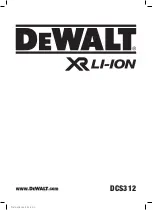
g)
If dust extraction and collec
tion systems are provided,
ensure that they are connected
and used correctly.
Use of dust
extraction systems can reduce
dust related hazards.
h)
Do not assume a false sense
of security and do not overstep
the safety rules for power tools,
even if you are familiar with the
power tool after many uses.
Careless action can lead to seri-
ous injuries within split seconds.
4) Use and handling of the power
tool
a)
Do not overload your power
tool. Use the appropriate pow
er tool for the task in hand.
The
correct power tool will do the job
better and safer in the specified
performance range.
b)
Do not use the power tool if the
switch is defective.
Any power
tool that cannot be switched on
or off is dangerous and must be
repaired.
c)
Pull the plug out of the sock
et and/or remove a removable
battery pack before making any
changes to the device settings,
changing insertion tools or put
ting the power tool down.
This
precautionary safety measure pre-
vents the risk of the power tool
starting up accidentally.
d)
Keep power tools not in use
away of reach by children. Do
not anyone to operate the pow
er tool who is not familiar with
it, or who has not read these
instructions.
Power tools are
dangerous when used by inexpe-
rienced persons.
e)
Look after your power tools and
tool inserts carefully. Check
whether moving parts function
properly and do not bind, check
whether parts are broken or
damaged in such a way that the
functionality of the power tool
is affected. Have any damaged
parts repaired before using
the power tool.
Many accidents
are caused by poorly maintained
power tools.
f)
Keep cutting tools sharp and
clean.
Properly maintained cutting
tools with sharp cutting edges are
less likely to jam and are easier to
control.
g)
Use the power tool, insertion
tool, insertion tools, etc. in
accordance with these instruc
tions. Take the working condi
tions and the task to be com
pleted into account.
Using the
power tool for purposes for which
it was not intended may result in a
hazardous situation.
h)
Keep handles and grips dry,
clean, and free from oil and
grease.
Slippery handles and
grips do not allow safe operation
and control of the power tool in
unforeseen situations.
5) Service
a)
Have your power tool serviced
by a qualified technician using
only original spare parts.
This
ensures that the safety of your
power tool is maintained.
76
MW-5461570-Bedien-2003.indd 76
MW-5461570-Bedien-2003.indd 76
04.05.20 16:46
04.05.20 16:46
















































